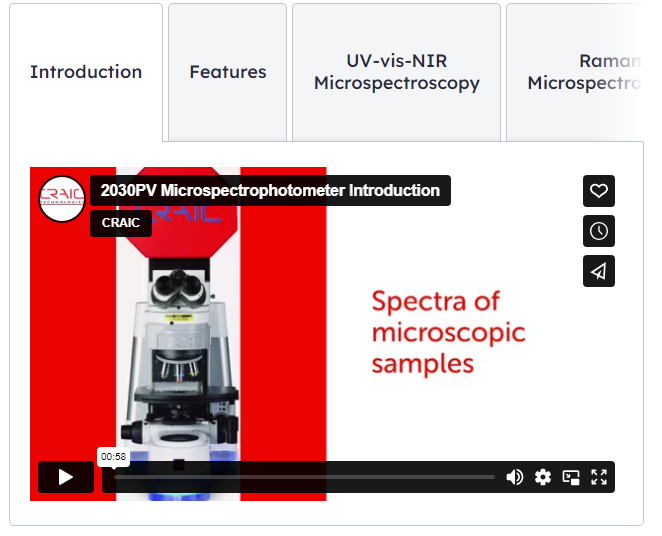Press Release CRAIC | Seeing Red: Microspectrophotometric Evidence for Color Blindness in Sharks
CRAIC Technologies, Inc.
948 N. Amelia Ave.
San Dimas, CA 91773
USA
Information and Sales: sales@microspectra.com
Service and Support: support@microspectra.com
Details
Seeing Red: Microspectrophotometric Evidence for Color Blindness in Sharks
Sharks, with their sophisticated sensory systems, have evolved to become apex predators in the marine environment. A key aspect of their sensory array is vision, a subject of intrigue and research. A landmark study using point-measurement microspectrophotometry has provided significant insights into the visual capabilities of sharks, particularly regarding their potential for color vision.
Microspectrophotometric Analysis of Shark Vision
In the groundbreaking study on shark vision, microspectrophotometry played a central role. This technique allows for precisely measuring visual pigments' absorbance spectra in the retinal photoreceptors. By focusing on these pigments, researchers can discern the types of photoreceptors present and their specific light-absorbing properties.
Microspectrophotometry involves isolating individual photoreceptors from shark retinas and measuring the wavelength of light each type absorbs most strongly. This approach is critical for understanding visual perception in sharks, as it reveals the spectral sensitivity of their photoreceptors. In most animals, including humans, color vision is facilitated by multiple types of cone photoreceptors, each sensitive to different wavelengths of light. By determining the number and types of cone cells in sharks, researchers can infer their capacity for color vision.
In this study, the researchers meticulously analyzed the retinal tissues of 17 shark species, carefully extracting and examining their photoreceptors. This detailed analysis provided a comprehensive view of the visual capabilities of these species. The precision of microspectrophotometry allowed for the accurate determination of the λmax (wavelength of maximum absorbance) for both rods and cones, which is crucial for understanding how sharks perceive their underwater environment.
Microspectrophotometry in this context is particularly significant due to aquatic environments' unique challenges. Light behaves differently underwater, with certain wavelengths being absorbed more than others. Understanding the spectral tuning of shark photoreceptors provides insight into how these predators have adapted to their specific ecological niches.
By employing this advanced technique, the researchers could delve deeper into the photoreceptor composition of sharks than ever before, leading to the unexpected discovery of potential cone monochromacy. This finding challenges our understanding of shark sensory capabilities and underscores the importance of microspectrophotometry in biological research, particularly in studying organisms in complex and variable environments like the ocean.
Spectral Tuning of Rod and Cone Visual Pigments in Sharks
The findings revealed that sharks have a spectral tuning in their rod and cone visual pigments across different species. Rods, responsible for low-light vision, showed a wavelength of maximum absorbance (λmax) ranging from 484 to 518 nm. The cones, typically associated with color vision, had a λmax between 532 and 561 nm. However, each shark species was found to have only a single long-wavelength-sensitive cone type.
The Role of Microspectrophotometry in Understanding Shark Vision
The revelation of potential cone monochromacy in sharks, as uncovered by the study, has far-reaching implications in several domains, including marine biology, ecology, and human interactions with marine life.
- Ecological and Evolutionary Insights: Understanding that sharks may be cone monochromats opens new avenues in the study of marine evolutionary biology. It suggests a possible convergent evolutionary path with certain marine mammals exhibiting a single cone type. This similarity could indicate similar selective pressures in the aquatic environment, leading to comparable adaptations across different species. Further, studying shark vision can provide insights into how these predators interact with their environment, influencing their hunting strategies and habitat preferences.
- Shark Conservation and Fisheries Management: The potential color blindness in sharks has significant implications for conservation efforts. It can inform the design of fishing gear, particularly in reducing bycatch in long-line fisheries. By understanding the visual triggers for sharks, fishing lures and baits can be designed to be less attractive to them, helping to mitigate the substantial bycatch issue.
- Public Safety and Shark Interaction: For public safety, especially in areas with high shark-human interactions, this research can guide the development of swimwear and watercraft that are less visually stimulating to sharks. Most shark attacks are believed to be incidents of curiosity rather than aggression. If sharks rely more on contrast than color, designing equipment and clothing that minimize visual contrast in the aquatic environment could reduce the likelihood of shark encounters.
- Future Research Directions: This discovery paves the way for further research into the sensory biology of sharks. It raises questions about how sharks compensate for the lack of color vision - possibly relying more on other senses like electroreception and olfaction. These aspects could provide a more comprehensive understanding of shark behavior and physiology.
- Educational and Public Perception: The study also has an educational aspect, helping to demystify sharks and potentially alter public perception. Understanding that sharks perceive the world differently from humans can foster a more nuanced view of these often misunderstood creatures, emphasizing their role as an integral part of the marine ecosystem rather than as mere predators.
The potential cone monochromacy in sharks has opened a new chapter in our understanding of these ancient marine creatures. It challenges previous notions and offers practical conservation, public safety, and ecological research applications. This finding underscores the need for continued and deeper investigation into the sensory worlds of marine life, particularly apex predators like sharks.
Interested in Microspectrophotometry?
The study on shark vision using microspectrophotometry underscores the profound impact of this technology in unraveling the complexities of the natural world. At CRAIC Technologies, we are committed to advancing this field. Our tools and expertise in microspectrophotometry have enabled groundbreaking research like this, offering new perspectives in biological and environmental sciences.
If you're intrigued by the potential of microspectrophotometry in your research, we invite you to explore further. Visit our learning blog and read What is a Microspectrophotometer? to discover how our technology can enhance your scientific investigations. Join us in pioneering the next wave of scientific discoveries!
References
Hart, Nathan Scott et al. “Microspectrophotometric evidence for cone monochromacy in sharks.” Die Naturwissenschaften vol. 98,3 (2011): 193-201. doi:10.1007/s00114-010-0758-8
Configurations
Reviews
Select your country to view all the provider contacts:

















































